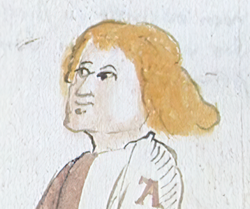|
|
You are not currently logged in. Are you accessing the unsecure (http) portal? Click here to switch to the secure portal. |
Difference between revisions of "Wiktenauer:Main page/Featured"
| Line 1: | Line 1: | ||
{{infobox writer | {{infobox writer | ||
| − | | name = | + | | name = Sigmund Schining ain Ringeck |
| image = File:Sigmund Ringeck.png | | image = File:Sigmund Ringeck.png | ||
| imagesize = 250px | | imagesize = 250px | ||
Revision as of 01:42, 11 September 2015
| Sigmund Schining ain Ringeck | |
|---|---|
 | |
| Period | 15th century |
| Occupation | Fencing master |
| Nationality | German |
| Patron | Albrecht, Duke of Bavaria |
| Movement | Society of Liechtenauer |
| Influences | Johannes Liechtenauer |
| Influenced | |
| Genres | Fencing manual |
| Language | Early New High German |
| Archetype(s) | Hypothetical |
| Manuscript(s) |
MS E.1939.65.341 (1508)
|
| First printed english edition |
Tobler, 2001 |
| Concordance by | Michael Chidester |
Sigmund Schining ain Ringeck (Sigmund ain Ringeck, Sigmund Amring, Sigmund Einring, Sigmund Schining) was a 15th century German fencing master. While the meaning of the surname "Schining" is uncertain, the suffix "ein Ringeck" may indicate that he came from the Rhineland region of south-eastern Germany. He is named in the text as Schirmaister to Albrecht, Count Palatine of Rhine and Duke of Bavaria. This may signify Schirrmeister, a logistical officer charged with oversseing the wagons and horse-drawn artillery pieces, or potentially Schirmmeister, a title used by lower-class itinerant fencing masters in the Medieval period. Apart from his service to the duke, the only thing that can be determined about his life is that his renown as a master was sufficient for Paulus Kal to include him on his memorial to the masters of the Society of Liechtenauer in 1470.
The identity of Ringeck's patron remains unclear, as four men named Albrecht ruled Bavaria during the fifteenth century; assuming that Ringeck was a personal student of Liechtenauer, further narrows the list down to just two. If the MS 3227a is correctly dated to 1389, then Liechtenauer was a 14th century master and Ringeck's patron was Albrecht I, who reigned from 1353 to 1404. If, on the other hand, Liechtenauer was an early 15th century master (an associate or student of H. Beringer) and the Society of Liechtenauer was assembled to fight in the Hussite Wars of the 1420s and 30s, then Ringeck's patron would have been Albrecht III, who carried the title from 1438 to 1460. Albrecht IV claimed the title in 1460 and thus also could have been Ringeck's patron; this would probably signify that Ringeck was not a direct student of Liechtenauer at all, but a later inheritor of the tradition. That said, Albrecht IV lived until 1508 and so the Dresden, Glasgow, and Salzburg manuscripts were likely created during his reign.
Ringeck is often erroneously credited as the author of the MS Dresd.C.487. Ringeck was indeed the author of one of the core texts, a complete gloss of Liechtenauer's Recital on unarmored long sword fencing. However, the remainder of the manuscript contains an assortment of treatises by several different masters in the tradition, and it is currently thought to have been composed in the early 16th century (putting it after the master's presumed lifetime). Regardless, the fact that he authored one of the few glosses of the Recital makes Ringeck one of the most important masters of the Liechtenauer tradition.
(Read more...)
- Recently Featured:
- Joachim Meÿer – Paulus Hector Mair – Die Blume des Kampfes – Verzeichnis etlicher Stücke des Fechtens im Rapier
